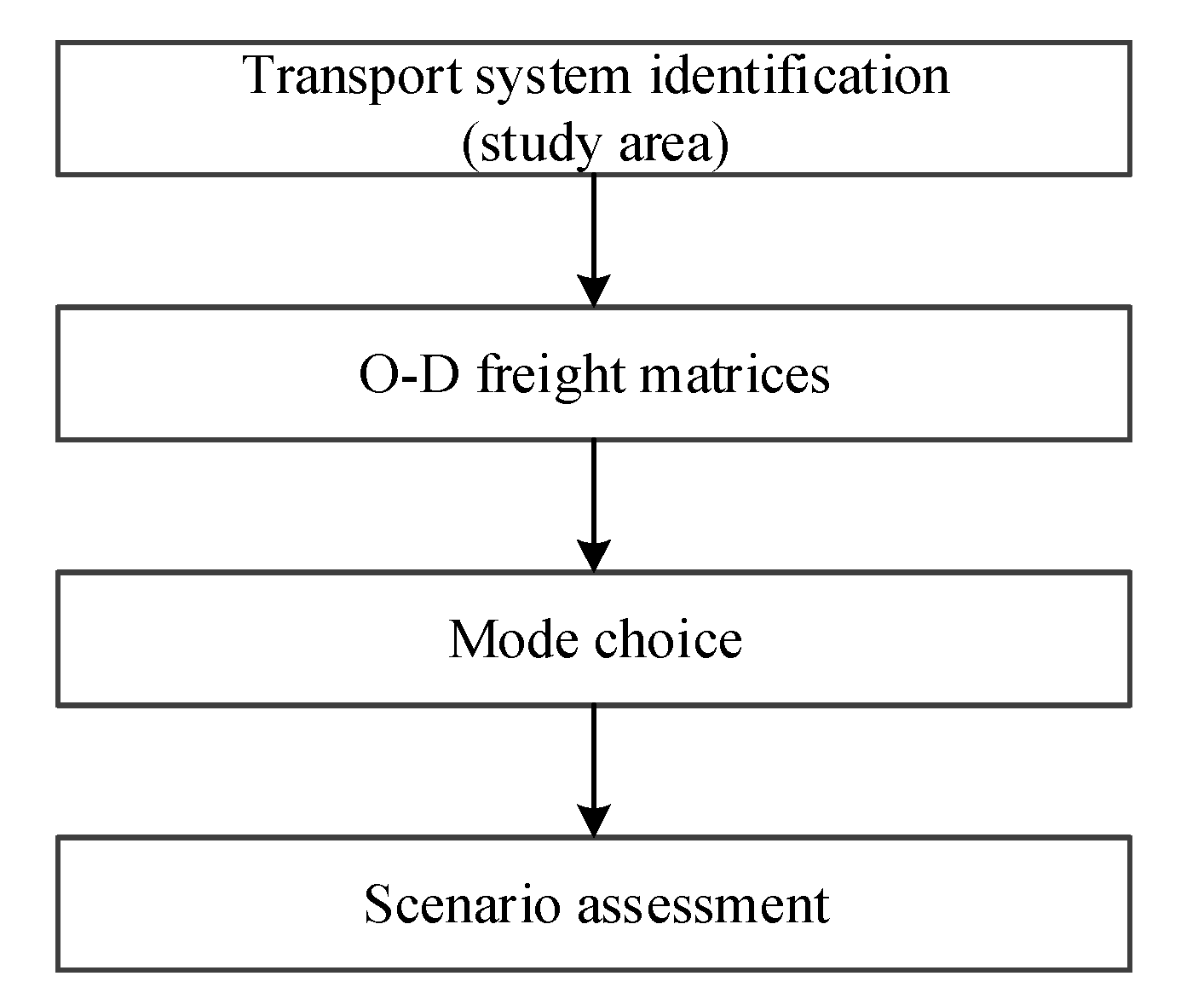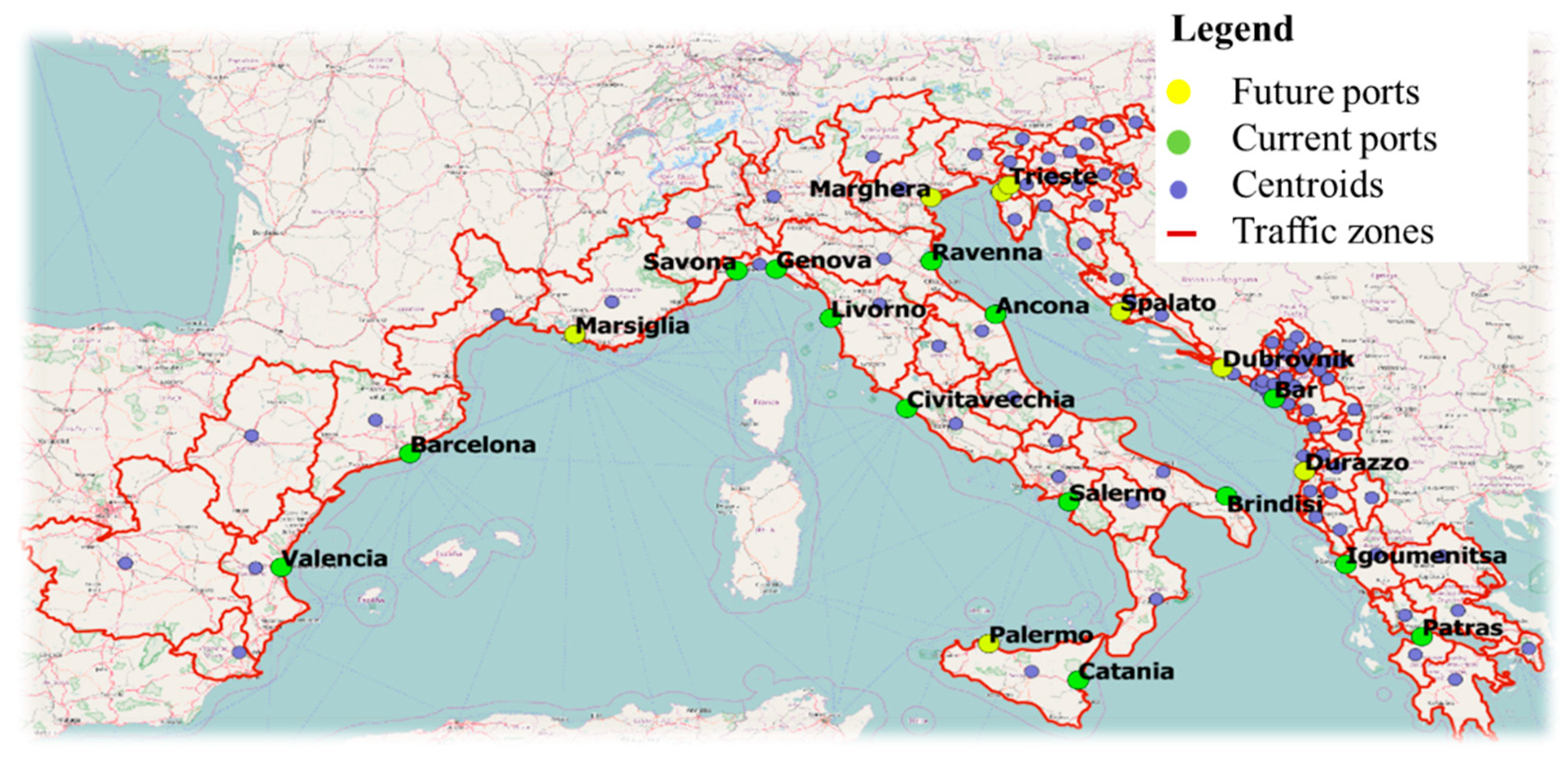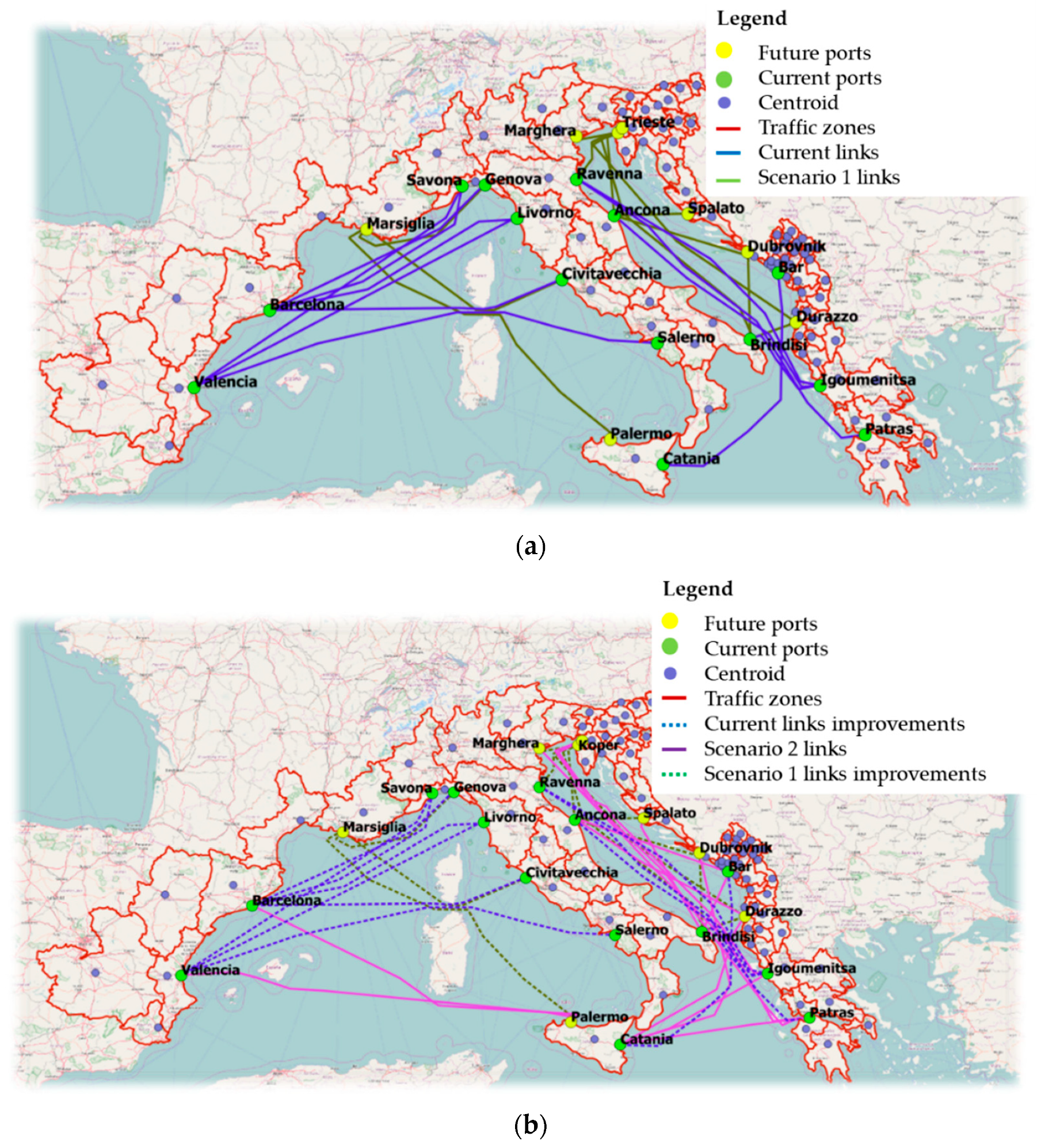Assessing the Potential of Short Sea Shipping and the Benefits in Terms of External Costs: Application to the Mediterranean Basin
Abstract
1. Introduction
2. Literature Review
3. Approach
- Transportation system identification (study area). The objective of this first phase is to identify the elements of the system under analysis and their relationships;
- Origin-Destination (O-D) matrices. This stage aims to estimate the O-D matrices, and it is integrated and related to transportation system identification;
- Mode choice. The relevant interactions among the various elements of the freight transportation system are simulated in order to assess how socio-economic characteristics as well as level of service attributes impact on modal choices; this phase provides the input for future scenario assessment;
- Future scenario assessment. Different design scenarios have been implemented according to different hypotheses on the further development of SSS services coming from national and supra-national plans. Subsequently, some scenario metrics and/or performance indicators are calculated and the impacts for the proposed future scenarios, which could be compared with target ones, are estimated.
3.1. Transportation System Identification
- The demographic, economic and spatial characteristics of transport demand;
- The supply of transport and logistics infrastructures and services;
- The external environment, as it plays a role in estimating some impacts.
3.2. Origin-Destination Matrices
- Xo is the value of production in region o (equal to the regional GDP);
- cod is the average transport costs between zones o and d;
- R is the origin country that contains zone o;
- S is the destination country that contains zone d;
- qRS is the freight flow (quantity) between countries R and S;
- βo and βc are model parameters to calibrate.
3.3. Mode Choice
3.4. Scenario Assessment
- Impacts on users (e.g., travel time and generalized travel cost);
- Impacts on non-user externalities (e.g., air pollution, energy consumption).
4. The Case Study
4.1. Transportation System Identification
- Italy, with the ports of Ancona, Brindisi, Catania, Civitavecchia, Genova, Livorno, Marghera and Ravenna, Salerno, Savona, Trieste;
- France with the port of Marseille;
- Spain with the ports of Barcelona and Valencia;
- Slovenia with the port of Koper;
- Croatia with the ports of Dubrovnik and Split;
- Montenegro with the port of Bar;
- Albania with the port of Durres;
- Greece with the ports of Igoumenitsa and Patras.
4.1.1. Short Sea Shipping Supply Model
4.1.2. Railway Supply Model
4.1.3. Road Supply Model
4.2. Origin-Destination Matrices
4.3. Mode Choice
4.4. Future Scenario Assessment
- Introduction of new services in line with EU projects as detailed below (scenario 1);
- Introduction of new SSS services on long-distance connections characterized by the presence of potentially attractive demand from road transport (scenario 2);
- Boosting of services due to a 10% increase in frequencies of existing SSS services (scenario 2).
4.4.1. Scenario 1
4.4.2. Scenario 2
4.4.3. Externality Scenario Comparison
- is the annual tons-km covered by transport mode m in scenario h;
- tkms,m is the unit cost for externality s (e.g., air pollutant emissions, greenhouse gas emissions, accidents, congestion, noise) due to transport mode m as proposed by the Handbook on External Costs of Transport.
5. Conclusions
Author Contributions
Funding
Acknowledgments
Conflicts of Interest
References
- White Paper. Tabella di Marcia Verso Uno Spazio Unico Europeo Dei Trasporti—Per Una Politica Dei Trasporti Competitiva E Sostenibile; Commissione Europea: Bruxelles, Belgium, 2011. [Google Scholar]
- Eurostat. Glossary: Short Sea Shipping (SSS). Available online: https://ec.europa.eu/eurostat/statistics-explained/index.php?title=Glossary:Short_sea_shipping_(SSS)&oldid=424626 (accessed on 18 May 2020).
- Douet, M.; Cappuccilli, J.F. A Review of Short Sea Shipping Policy in the European Union. J. Transp. Geogr. 2011, 19, 968–976. [Google Scholar] [CrossRef]
- Russo, F.; Musolino, G.; Assumma, V. An integrated procedure to estimate demand flows of maritime container transport at international scale. Int. J. Shipp. Transp. Logist. 2014, 6, 1121–1132. [Google Scholar] [CrossRef]
- Lupi, M.; Farina, A.; Pratelli, A.; Gazzarri, A. Evoluzione Della Rete Italiana Delle Autostrade Del Mare. R.E.P.O.T. Riv. Sci. Della Soc. Ital. Econ. Trasp. Della Logist. 2015, 1, 1–17. [Google Scholar]
- Lupi, M.; Pratelli, A.; Falleni, M.; Farina, A. An analysis of short sea shipping container routes in the Mediterranean and in the black sea. WSEAS Trans. Environ. Dev. 2019, 15, 1201–1238. [Google Scholar]
- COP 21. Adoption of the Paris agreement. In Proceedings of the Parties Twenty-First Session (COP 21), Paris, France, 30 November–11 December 2015. [Google Scholar]
- European Environment Agency. Greenhouse Gas Emissions from Transport in Europe. Available online: https://www.eea.europa.eu/ (accessed on 23 June 2020).
- Goulielmos, A.; Giziakis, C.; Christodoulou, A. A future regulatory framework for CO2 emissions of shipping in the Mediterranean Area. Int. J. Euro-Mediterr. Stud. 2011, 4, 39–60. [Google Scholar]
- Christodoulou, A.; Gonzalez-Aregall, M.; Linde, T.; Vierth, I.; Cullinane, K. Targeting the reduction of shipping emissions to air: A global review and taxonomy of policies, incentives and measures. Marit. Bus. Rev. 2019, 4, 16–30. [Google Scholar] [CrossRef]
- Christodoulou, A.; Woxenius, J. Sustainable Short Sea Shipping. Sustainability 2019, 11, 2874. [Google Scholar] [CrossRef]
- Paixão Casaca, A.C.; Marlow, P.B. Logistics strategies for short sea shipping operating as part of multimodal transport chains. Marit. Policy Manag. 2009, 36, 1–19. [Google Scholar]
- Tavasszy, L.; de Jong, G. Data Availability and Model Form. In Modelling Freight Transport; Tavasszy, L., De Jong, J., Eds.; Elsevier: Amsterdam, The Netherlands, 2014; Chapter 10; pp. 229–244. [Google Scholar] [CrossRef]
- Raza, Z. Effects of Regulation-Driven Green Innovations on Short Sea Shipping’s Environmental and Economic Performance. Transp. Res. Part D Transp. Environ. 2020, 84, 102340. [Google Scholar] [CrossRef]
- Tran, T.M.T.; Yuen, K.F.; Li, K.X.; Balci, G.; Ma, F. A Theory-Driven Identification and Ranking of the Critical Success Factors of Sustainable Shipping Management. J. Clean. Prod. 2020, 243, 118401. [Google Scholar] [CrossRef]
- Yuen, K.F.; Thai, V.V. Corporate Social Responsibility and Service Quality Provision in Shipping Firms: Financial Synergies or Trade-Offs? Marit. Policy Manag. 2017, 44, 131–146. [Google Scholar] [CrossRef]
- Yuen, K.F.; Lim, J.M. Barriers to the Implementation of Strategic Corporate Social Responsibility in Shipping. Asian J. Shipp. Logist. 2016, 32, 49–57. [Google Scholar] [CrossRef]
- Van den Bos, G.; Wiegmans, B. Short sea shipping: A statistical analysis of influencing factors on SSS in European countries. J. Shipp. Trade 2018, 3, 6. [Google Scholar] [CrossRef]
- Russo, F.; Musolino, G.; Assumma, V. Competition between Ro–Ro and Lo–Lo Services in Short Sea Shipping Market: The Case of Mediterranean Countries. Res. Transp. Bus. Manag. 2016, 19, 27–33. [Google Scholar] [CrossRef]
- Papadimitriou, S.; Lyridis, D.V.; Koliousis, I.; Tsioumas, V.; Sdoukopoulos, E.; Stavroulakis, P.J. The Dynamics of Short Sea Shipping: New Practices and Trends. In Palgrave Studies in Maritime Economics; Palgrave Macmillan: London, UK, 2018. [Google Scholar]
- López-Navarro, M.Á. Environmental Factors and Intermodal Freight Transportation: Analysis of the Decision Bases in the Case of Spanish Motorways of the Sea. Sustainability 2014, 6, 1544–1566. [Google Scholar] [CrossRef]
- Arof, A.M. Decision Making Model for Ro-Ro Short Sea Shipping Operations in Archipelagic Southeast Asia. Asian J. Shipp. Logist. 2018, 34, 33–42. [Google Scholar] [CrossRef]
- Bergantino, A.; Bolis, S.; Canali, C. A Methodological Framework to Analyse the Market Opportunities of Short Sea Shipping: The Adaptive Stated Preference approach. In Towards Better Performing European Transport Networks; Jourquin, B., Rietveld, P., Westin, K., Eds.; Routledge: London, UK, 2006; pp. 285–304. [Google Scholar]
- Brooks, M.R.; Puckett, S.M.; Hensher, D.A.; Sammons, A. Understanding Mode Choice Decisions: A Study of Australian Freight Shippers. Marit. Econ. Logist. 2012, 14, 274–299. [Google Scholar] [CrossRef]
- PaixaoCasaca, A.C.; Galvao, C.B.; Robles, L.T.; Cutrim, S.S. Domestic Short Sea Shipping Services in Brazil: Competition by Enhancing Logistics Integration. Int. J. Shipp. Transp. Logist. 2017, 9, 280. [Google Scholar] [CrossRef]
- Yotsov, I.V.; Dimitrakiev, D.Y.; Zaburtov, A.; Koritarov, T.D. Analysis of the Logistics Transport Corridors in Black Sea Region Based on the Short Sea Shipping Concept. In Proceedings of the Annual General Assembly of the International Association of Maritime Universities, Barcelona, Spain, 11–13 October 2017. [Google Scholar]
- López, A.M.; Sobrino, P.C.; Santos, L.C. Definition of Optimal Fleets for Sea Motorways: The Case of France and Spain on the Atlantic Coast. Int. J. Shipp. Transp. Logist. 2015, 7, 89–113. [Google Scholar]
- Koliousis, I.; Koliousis, P.; Papadimitriou, S. Estimating the Impact of Road Transport Deregulation in Short Sea Shipping: Experience from Deregulation in the European Union. Int. J. Shipp. Transp. Logist. 2013, 5, 500–511. [Google Scholar] [CrossRef]
- López-Navarro, M.Á. Unaccompanied transport as a strategy for international road hauliers in Ro-Ro short sea shipping. Marit. Econ. Logist. 2013, 15, 374–394. [Google Scholar] [CrossRef]
- Windover, P.; Roy, B.; Tario, J. Electric Propulsion in Short Sea Shipping. World Electr. Veh. J. 2012, 5, 288–299. [Google Scholar] [CrossRef]
- Spoof-Tuomi, K.; Niemi, S. Environmental and Economic Evaluation of Fuel Choices for Short Sea Shipping. Clean Technol. 2020, 2, 34–52. [Google Scholar] [CrossRef]
- Santos, T.A.; Soares, C.G. Methodology for Ro-Ro Ship and Fleet Sizing with Application to Short Sea Shipping. Marit. Policy Manag. 2017, 44, 859–881. [Google Scholar] [CrossRef]
- López, A.M.; Kronbak, J.; Jiang, L. Cost and Time Models for the Evaluation of Intermodal Chains by Using Short Sea Shipping in the North Sea Region: The Rosyth-Zeebrugge Route. Int. J. Shipp. Transp. Logist. 2015, 7, 494–520. [Google Scholar] [CrossRef]
- Hjelle, H.M. Atmospheric Emissions of Short Sea Shipping Compared to Road Transport Through the Peaks and Troughs of Short-Term Market Cycles. Transp. Rev. 2014, 34, 379–395. [Google Scholar] [CrossRef]
- Vallejo-Pinto, J.A.; Garcia-Alonso, L.; Álvarez Fernández, R.; Mateo-Mantecón, I. Iso-Emission Map: A Proposal to Compare the Environmental Friendliness of Short Sea Shipping vs. Road Transport. Transp. Res. Part D Transp. Environ. 2019, 67, 596–609. [Google Scholar] [CrossRef]
- Konstantinus, A.; Zuidgeest, M.; Christodoulou, A.; Raza, Z.; Woxenius. Barriers and Enablers for Short Sea Shipping in the Southern African Development Community. Sustainability 2019, 11, 1532. [Google Scholar] [CrossRef]
- Bengtsson, S.K.; Fridell, E.; Andersson, K.E. Fuels for Short Sea Shipping: A Comparative Assessment with Focus on Environmental Impact. Proc. Inst. Mech. Eng. Part M J. Eng. Marit. Environ. 2013, 228. [Google Scholar] [CrossRef]
- Mulligan, R.F.; Lombardo, G.A. Short Sea Shipping: Alleviating the Environmental Impact of Economic Growth. WMU J. Marit. Aff. 2006, 5, 181–194. [Google Scholar] [CrossRef]
- Medda, F.; Trujillo, L. Short-sea shipping: An analysis of its determinants. Marit. Policy Manag. Flagship J. Int. Shipp. Port Res. 2010, 37, 285–303. [Google Scholar] [CrossRef]
- Johnson, H.; Styhre, L. Increased Energy Efficiency in Short Sea Shipping through Decreased Time in Port. Transp. Res. Part A Policy Pr. 2015, 71, 167–178. [Google Scholar] [CrossRef]
- Johnson, H.; Johansson, M.; Andersson, K. Barriers to improving energy efficiency in short sea shipping: An action research case study. J. Clean. Prod. 2014, 66, 317–327. [Google Scholar] [CrossRef]
- Schøyen, H.; Brathen, S. Measuring and Improving Operational Energy Efficiency in Short Sea Container Shipping. Res. Transp. Bus. Manag. 2015, 17, 26–35. [Google Scholar] [CrossRef]
- Casaca, A.C.P.; Marlow, P.B. The Impact of the Trans-European Transport Networks on the Development of Short Sea Shipping. Marit. Econ. Logist. 2007, 9, 302–323. [Google Scholar] [CrossRef]
- Christodoulou, A.; Raza, Z.; Woxenius, J. The Integration of RoRo Shipping in Sustainable Intermodal Transport Chains: The Case of a North European RoRo Service. Sustainability 2019, 11, 2422. [Google Scholar] [CrossRef]
- Nuzzolo, A.; Coppola, P.; Comi, A. Freight transport modeling: Review and future challenges. Int. J. Transp. Econ. 2013, 40, 151–181. [Google Scholar]
- Tavasszy, L.; De Jong, J. Modelling Freight Transport; Elsevier Ltd.: Amsterdam, The Netherlands, 2014. [Google Scholar]
- Cascetta, E.; Marzano, V.; Papola, A.; Aponte, D.; D’Agostino, Z.; Varrone, M. The Role of Modelling in Freight Governance: The Case of LOGICA (Agency For Freight Transport and Logistics Promotion of the Campania Region). In Proceedings of the European Transport Conference, Strasbourg, France, 1 October 2005. [Google Scholar]
- Nuzzolo, A.; Russo, F. Modal Split at International Level: A System of Models for Italian-Based Freight. In Proceedings of the European Transport Conference, London, UK, 1–5 September 1997. [Google Scholar]
- Rotaris, L.; Danielis, R.; Sarman, I.; Marcucci, E. Testing for Nonlinearity in the Choice of a Freight Transport Service. Eur. Transp.—Transp. Eur. 2012, 50, 1–22. [Google Scholar]
- Delle Site, P.; Kilani, K.; Gatta, V.; Marcucci, E.; de Palma, A. Estimation of consistent Logit and Probit models using best, worst and best–worst choices. Transp. Res. Part B Methodol. 2019, 128, 87–106. [Google Scholar] [CrossRef]
- Dobranskyte-Niskota, A.; Perujo, A.; Pregl, M. Indicators to Assess Sustainability of Transport Activities—Part 1: Review of the Existing Transport Sustainability Indicators Initiatives and Development of an Indicator Set to Assess Transport Sustainability Performance; European Commission: Luxembourg, 2007. [Google Scholar]
- Di Gangi, M.; Polimeni, A. A model to simulate multimodality in a mesoscopic dynamic network loading framework. J. Adv. Transp. 2017, 2017. [Google Scholar] [CrossRef]
- Nuzzolo, A.; Crisalli, A.; Comi, A. An aggregate transport demand model for import and export flow simulation. Transport 2015, 30, 43–54. [Google Scholar] [CrossRef]
- Ben-Akiva, M.; Lerman, S.R. Discrete Choice Analysis: Theory and Application to Travel Demand; The MIT Press: Cambridge, MA, USA, 1985. [Google Scholar]
- Train, K.E. Discrete Choice Methods with Simulation; Cambridge University Press: Cambridge, UK, 2009. [Google Scholar]
- Nuzzolo, A.; Comi, A. Individual utility-based path suggestions in transit trip planners. IET Intell. Transp. Syst. 2016, 10, 219–226. [Google Scholar] [CrossRef]
- De Jong, G.; Schroten, A.; Van Essen, H.; Otten, M.; Bucci, P. Price Sensitivity of European Road Freight Transport–Towards a Better Understanding of Existing Results: A Report for Transport & Environment; Report 9012-1; CE Delft: Delft, The Netherlands, 2010. [Google Scholar]
- Crisalli, U.; Comi, A.; Rosati, L. A methodology for the assessment of rail-road freight transport policies. Procedia Soc. Behav. Sci. 2013, 87, 292–305. [Google Scholar] [CrossRef]
- HECT. Handbook on External Costs of Transport; European Commission: Brussels, Belgium, 2019. [Google Scholar]






| O-D [tons/year] | Spain | Italy | Montenegro | Greece |
|---|---|---|---|---|
| Spain | - | SSS: 652,000 (26%) Railway: 272,000 (5%) Road: 3,664,000 (69%) | - | - |
| Italy | SSS: 603,000 (28%) Railway: 141,000 (3%) Road: 3,294,000 (69%) | - | SSS: 1000 (50%) Railway: 8000 (35%) Road: 9000 (15%) | SSS: 245,000 (73%) Railway: 9000 (0%) Road: 858,000 (27%) |
| Montenegro | - | SSS: 1000 (58%) Railway: 2000 (16%) Road: 10,000 (26%) | - | - |
| Greece | - | SSS: 256,000 (70%) Railway: 2000 (0%) Road: 947,000 (30%) | - | - |
| Attribute/ Mode Alternative | SSS | Combined Road-Rail | Road |
|---|---|---|---|
| Time (h) | −0.0403 | −0.0408 | −0.0386 |
| Cost (€) | −0.6572 | −0.7646 | −0.5241 |
| Frequency (runs/week) | 0.0300 | 0.0182 | - |
| ASA | - | −0.7418 | 1.1046 |
| R2 | 0.98 | ||
| VoT (€/h) | 61.34 | 53.41 | 73.71 |
| Percentage Variation of the Cost | SSS | Combined Road-Rail | Road |
|---|---|---|---|
| SSS: ΔCsea/Csea = +10% | −0.61 | 0.29 | 0.31 |
| Combined road-rail: ΔCrail/Crail = +10% | 0.02 | −0.68 | 0.03 |
| Road: ΔCroad/Croad = +10% | 0.65 | 0.70 | −0.39 |
| Transport Mode | Base Scenario | Scenario 1 | Scenario 1 vs. Base Scenario |
|---|---|---|---|
| SSS | 12% | 24% | 106% |
| Combined road-rail | 2% | 2% | −21% |
| Road | 86% | 74% | −14% |
| Transport Mode | Base Scenario | Scenario 1 | Scenario 1 vs. Base Scenario |
|---|---|---|---|
| SSS | 13% | 24% | 68% |
| Combined road-rail | 3% | 3% | −23% |
| Road | 84% | 73% | −21% |
| Transport Mode | Base Scenario | Scenario 2 | Scenario 2 vs. Base Scenario |
|---|---|---|---|
| SSS | 12% | 31% | 167% |
| Combined road-rail | 2% | 2% | −30% |
| Road | 86% | 67% | −22% |
| Transport Mode | Base Scenario | Scenario 2 | Scenario 2 vs. Base Scenario |
|---|---|---|---|
| SSS | 13% | 32% | 123% |
| Combined road-rail | 3% | 2% | −29% |
| Road | 84% | 66% | −24% |
| Scenario 1 vs. Base Scenario | |||
| SSS | Combined Road-Rail | Road | |
| air pollutant | 91% | −23% | −21% |
| accidents | 93% | −23% | −21% |
| congestion | 93% | −21% | |
| noise | 93% | −23% | −21% |
| greenhouse | 70% | −23% | −21% |
| Total | 86% | −23% | −21% |
| Average | −16% | ||
| Scenario 2 vs. Base Scenario | |||
| SSS | Combined Road-Rail | Road | |
| air pollutant | 147% | −29% | −24% |
| accidents | 148% | −29% | −24% |
| congestion | 148% | −24% | |
| noise | 148% | −29% | −24% |
| greenhouse | 125% | −29% | −24% |
| Total | 142% | −29% | −24% |
| Average | −19% | ||
© 2020 by the authors. Licensee MDPI, Basel, Switzerland. This article is an open access article distributed under the terms and conditions of the Creative Commons Attribution (CC BY) license (http://creativecommons.org/licenses/by/4.0/).
Share and Cite
Comi, A.; Polimeni, A. Assessing the Potential of Short Sea Shipping and the Benefits in Terms of External Costs: Application to the Mediterranean Basin. Sustainability 2020, 12, 5383. https://doi.org/10.3390/su12135383
Comi A, Polimeni A. Assessing the Potential of Short Sea Shipping and the Benefits in Terms of External Costs: Application to the Mediterranean Basin. Sustainability. 2020; 12(13):5383. https://doi.org/10.3390/su12135383
Chicago/Turabian StyleComi, Antonio, and Antonio Polimeni. 2020. "Assessing the Potential of Short Sea Shipping and the Benefits in Terms of External Costs: Application to the Mediterranean Basin" Sustainability 12, no. 13: 5383. https://doi.org/10.3390/su12135383
APA StyleComi, A., & Polimeni, A. (2020). Assessing the Potential of Short Sea Shipping and the Benefits in Terms of External Costs: Application to the Mediterranean Basin. Sustainability, 12(13), 5383. https://doi.org/10.3390/su12135383






